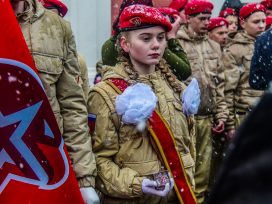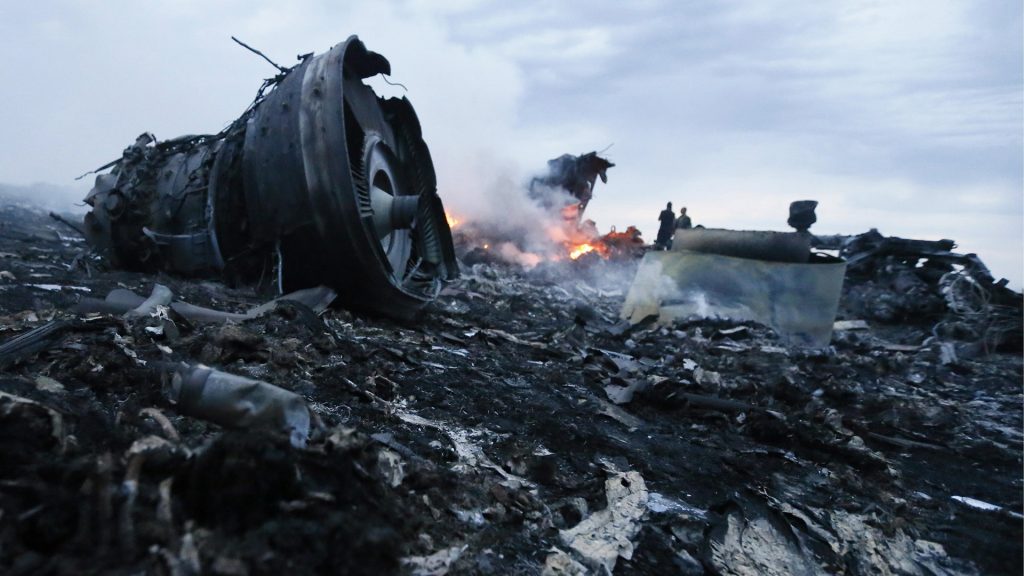The name Bellingcat is synonymous with open source investigation in the fields of conflict, crime and human rights abuses. Set up in 2014 as a citizens’ journalism platform, the techniques for which Bellingcat is famed – particularly geolocation – have become a staple of journalistic practice. Two stories above all have been integral to Bellingcat’s development: the shooting down of the MH17 flight over eastern Ukraine on 17 July 2014, and the chemical weapons attacks carried out by the Syrian army since 2017.
In the MH17 case, Bellingcat has succeeded in reconstructing events immediately before and after the incident, including the chain of command responsible for the atrocity. And in Syria, Bellingcat has proved that the Assad regime continued to use sarin and chlorine bombs against the civilian population even after it had claimed to have destroyed its chemical weapons arsenal in August 2013.
On 9 March 2020, the Joint Investigation Team (JIT) trial of four men charged with murder in connection with the shooting down of MH17 opened in The Netherlands. The trial reopens on 8 June, having been adjourned at the end of March. And on 8 April 2020, the Organization for the Prohibition of Chemical Weapons (OPCW) released its report on two chemical weapons attacks at Al Lataminah, northern Syria, on 24 and 30 March 2017.
Eurozine talks to Bellingcat founder and director Eliot Higgins about the MH17 trial and the OPCW report; about the disinformation that surrounds both MH17 and chemical weapons-use in Syria; and about Bellingcat’s role and organizational character.
Simon Garnett: What are your feelings on seeing the MH17 case finally being tried? How far has the JIT corroborated Bellingcat’s investigation? Do you expect new details to emerge?
Eliot Higgins: Previously the Joint Investigation Team had made statements in which they had effectively confirmed all that we’ve been saying. But what we’re seeing now is evidence that isn’t open source. This adds an extra layer of verification to what we already knew, but also expands on that. We’ve been fascinated to hear all these little details, for example, that they have one witness who – from what we understand – was at the guard post next to the launch site, in other words a pretty significant witness. We’re really looking forward to hearing what the witnesses have to say.
We’re also really interested to see how the defence responds to all of this. In the initial stages of the trial, they seemed unprepared. For example, they used the airspace defence, when the prosecution had just spent a lot of time explaining why it wasn’t relevant to this case. When they come back in June to present their case, we’ll see what they have actually got.
But honestly, unless they go through some of the procedural stuff, I can’t think they can actually challenge a lot of this evidence. Even based on what we found through open source, there’s a vast amount of information, and I’m sure the Joint Investigation Team has far more than we have.
Simon Garnett: Has Bellingcat cooperated with the JIT investigation? Will you be giving evidence?
Eliot Higgins: We’re not giving evidence, but we have been handing over information to the JIT. It is generally all open source, so it’s out there anyway. If we’ve found some Russian officer and he’s got a social media profile, then as soon as we make it public it’s going to be deleted very quickly. So we’ve been showing that stuff to the joint investigation team and giving them a reasonable amount of time to preserve it.
There have been a couple of incidents when people have approached us with videos or photographs, when because we have recognized the value of the information to the JIT, we have passed it directly onto them. For us, the priority has been making sure that the JIT has the best chance possible, rather than trying to get scoops.
Simon Garnett: This raises questions about the role of a journalistic operation like yourselves, in relation to that of an official body like the JIT whose mandate is to deliver legal justice. Can that be problematic? Does it raise questions for your methodology?
Eliot Higgins: Bellingcat is often seen as being a journalism organization, but we actually do a lot of work in other areas, particularly around justice and accountability. We’ve had a lot of interest from bodies who work in those areas, not just the Joint Investigation Team, but also the International Criminal Court, the International Impartial and Independent Mechanism on Syria, various parts of the United Nations.
What we’re trying to do is develop a process for open source investigation and archiving. With MH17, where we’ve been asked to share material with the European Court of Human Rights, we had to go back and rewrite what we’d written so the material is presentable as evidence, which is very time consuming. Instead, we are now developing an archiving process that runs alongside an investigation, so that whatever we write can just be handed over as a case file.
Last year we began focusing on Saudi airstrikes in Yemen and here we’ve been working with the Global Legal Action Network to build case files. We’ve just submitted what we’ve collected so far to a UK government inquiry into arms export agreements to Saudi Arabia and whether they’re being violated. Because of MH17 and Syria, there has been recognition of the value of online open source investigation. But one of the big questions is how open-source evidence is used in courts, because no one has really done that in a significant way so far. What we establish with geolocation could, we imagine, be used as a pathway to find witnesses, to find original source documents and other details.
A big focus of Bellingcat now is building that kind of justice and accountability capability and sharing it with other organizations who also want to do open source investigations. For example, we’ve got over a million YouTube videos that have been archived by the Syrian Archive. If you can turn all that collected archive information into usable datasets, then you can do much more interesting things. You can look at patterns of behaviour, you can visualize entire landscapes and show how things have changed over time.
Simon Garnett: The MH17 story fell into a larger information war around the annexation of Crimea and the conflict in Donetsk. Is disinformation on MH17 and specifically Bellingcat’s reporting of it consistent with broader patterns?
Eliot Higgins: We have seen that there is a circular thing going on. In the initial aftermath of MH17 being shot down on 17 July 2014, various theories were proposed by random people online. These claims were also made by the separatists themselves. Then, on 21 July, the Russian Ministry of Defence held a press conference, presenting what they said was their evidence. They did a few interesting things here.
First of all, some of the stuff they presented had clearly been taken from the Internet. For example, they claimed that the video filmed on 18 July showing the missile-launcher travelling through Luhansk, missing a missile, was actually filmed in a completely different location under Ukrainian government control. This line was literally stolen from some website. I have seen Russia doing this at least since 2013 with the sarin attacks in Damascus, where their entire narrative was based on internet conspiracy theories.
At that 21 July press conference, not only did they falsify satellite imagery to suggest that the missile launchers had been moved from Ukrainian bases, they also presented a radar image supposedly showing that just after MH17 was shot down there was a Ukrainian SU25 within a few kilometres. That launched a whole range of conspiracy theories that went on for years, saying that a SU25 shot it down.
Then they said they had lost this radar data and couldn’t share it with the Dutch Safety Board or the Joint Investigation Team. Two years later, in September 2016, just a week before the JIT was due to give its first press conference, miracle of miracles: the Russians managed to find this missing data. The crazy thing is that they now say that this same data shows there was nothing within 30 kilometres of MH17 before it was shot down, and that the flight path of MH17 had not been changed by air traffic control in Ukraine, even though two years earlier they said it had. But they do not acknowledge their ‘error’. This was clearly an attempt to control the narrative. We see this time and time again.
Another thing the Russian authorities do is ask questions about the evidence they’re presenting rather than making clear statements about what it means. The online community and the pro-Kremlin media then take these questions and answer them in their extremely biased, very poor way. The Russian government will plant the seeds and then they’ll harvest them later for disinformation. You could see this pattern happen with MH17, and you could see it happen more broadly with Syria.
Simon Garnett: Once the evidence is presented in court, do you see these kinds of disinformation narrative fade? Do people not predisposed towards the facts alter their opinion? Does a process of rational debate assert itself?
Eliot Higgins: It is too early to say with the MH17 case, but based on experience and what I’m seeing already, definitely not. People just find new reasons to refute the evidence.
What’s important is that they don’t need to think about the evidence holistically. They just have to say that one pixel is out of place for the entire case to be fake. This is partly fuelled by how online communities operate, because if you have any opinion, no matter what it’s on – the earth is flat, bleach is good medicine, MH17 was shot down by Ukraine, there is no chemical weapons-use in Syria – you’ll find a likeminded online community. And there will be bloggers within that, there will be Twitter personalities, and I suppose there will now be people on TikTok. And if you do disagree with that community, you just find another community that agrees with you.
That creates more and more extreme behaviour and communities around certain topics. Often, the more extreme they are, the noisier they are on the Internet. With MH17 and Syria, and anything involving Russia, the Russian media will often take those voices and give them a platform on Russia Today or Sputnik, or in the Russian-language media. This is an additional dynamic on top of these alternative media ecosystems.
But I think the most damaging example is what has been happening in America with coronavirus. Donald Trump gives a daily briefing and says something insane, and Breitbart and friends – the alt-right media ecosystem – launder it, then that goes back to Fox News, who then make it a bit more mainstream, and Donald Trump sees that. It’s like a human centipede of disinformation, where both ends are stitched together.
This is what happens when you sacrifice the truth to serving power, which is basically what we’re seeing in America with the Republican Party at the moment. Misinformation is becoming mainstreamed and propaganda is basically replacing journalism.
Simon Garnett: To turn to the OPCW report on the chemical weapons attacks at al-Lataminah in Syria – did it tell you anything that you didn’t know? What did you find particularly interesting in it?
Eliot Higgins: These two attacks at al-Lataminah had nothing like the same amount of coverage as the Khan Sheikhoun attack on 4 April, which prompted a US military reaction as well as much attention from the conspiracy theorists and chemical weapons truthers, whose narratives were then picked up and promoted by Russia. We couldn’t find a single social media post about the 24 March attack at al-Lataminah: it was like it didn’t even happen. For the 30 March attack, there are a few videos, but not many.
At the time, people didn’t realize that sarin had been used. We only really went back to looking at al-Lataminah when the OPCW said they were investigating. Then we found these videos and this debris. We noticed that two filler caps recovered from the debris of the 30 March attack were identical to the caps found after the Khan Sheikhoun attack, which the OPCW had said were uniquely consistent with a Syrian chemical bomb. The Russians had published a diagram showing two Syrian chemical bombs as part of their defence of the Syrian government, not realizing that this was probably the first open source imagery of these bombs. By using these diagrams, we were able to establish that the debris from 30 March matched almost perfectly with an M4000 Syrian chemical bomb that could have been filled with sarin.
With the 24 March attack, we managed to get one video of the site after talking to the Syrian civil defence – they said they had more, but they would only share them with the OPCW. This showed a really heavy chunk of debris. We thought at the time that it could be the ballast from the front of one of the bombs in the diagrams. The OPCW report actually measured it and showed that it was from the ballast. Along with the other evidence, they could say that the M4000 chemical bomb was used in both al-Lataminah attacks. I’d spent two years trying to establish the identity of these bombs, so it was very satisfying to see them agree with my conclusions, which were based just on piecing stuff together with the likes of Forensic Architecture.
The OPCW also specifically addressed what the conspiracy theorists say: that the evidence was planted. The amount of effort that would have had to go into making it look so much like an actual attack would have been vast. The OPCW pointed out that it would be ridiculous to go to such lengths without then having the Syrian opposition media cover it and make a thing of it. So those were the two elements of the report that really stood out for me.
The 24 March attack shows that, just because a chemical attack happens, even with sarin, it doesn’t mean that we’ll find out about it. I’ve been tracking this since early 2013 and there are far more attacks happening in Syria than people would realize. The Global Public Policy Institute put out a report called ‘Nowhere to Hide’, in which they identified 340 chemical weapons incidents in Syria.
The chemical weapon truthers generally don’t understand that because they only react to what’s in the media. They don’t spend every single day of their life looking at every single video from Syria, looking at chemical weapons attacks and obsessing over that side of it. Because for them, it’s about reliving the traumas of 2003. I call it ‘Gulf War Derangement Syndrome’.
There is a vast amount of evidence that the Syrian government has been using chemical weapons. This isn’t just one ‘dodgy dossier’, this is years and years of research by multiple organizations, huge numbers of witnesses, video evidence, stuff that we wouldn’t have imagined having in 2003. If the US really, really wanted to invade Syria, they definitely would have done it by now. They can definitely find excuses to invade countries. We’ve seen that in the past. So, the argument that ‘they’re faking all these chemical weapon attacks so the Americans can invade’ is ridiculous.
Simon Garnett: Does disinformation about chemical weapons in Syria overlap with disinformation on other topics or is it a discrete narrative?
Eliot Higgins: You find that some members of the Stop War Coalition are now part of the chemical weapons truther community, which itself overlaps with the broader Syria community, who were the bloggers making a lot of noise in 2012, after attention had shifted from the conflict in Libya in 2011 to Syria following the death of Gaddafi. Some of it also came from the anti-NATO, anti-intervention crowd around Libya.
Over time you saw that the anti-intervention crowd merged with the pro-Assad crowd and the more conspiracy-minded, ‘Gulf War Derangement Syndrome’ crowd. They have personalities and websites that they all come across and visit. So, they have this alternative media ecosystem. When Russia started bombing Syria, the Syria community and the Russia community started to merge. They believed that Hillary Clinton was going to bomb Syria because of chemical weapons – so a lot of them became very pro-Trump. Some of the pro-Trump crowd was in turn drawn into that. You also saw alt-right media personalities getting more involved with conspiracy theories around Syria and to a lesser extent MH17, maybe because that’s more clear-cut.
Coronavirus conspiracy theories are now also becoming part of that. What you’re seeing is a dynamic where there are a lot of splits, because theories about 5G and so on are a bridge too far for some people. And because, as I’ve mentioned, these communities tend to lead to extreme behaviour and people find their self-worth online through demonstrating their loyalty to the cause, if someone starts saying, ‘you’re wrong about coronavirus being caused by 5G’, they really fall out with each other. That has been an interesting and quite amusing dynamic to watch.
Simon Garnett: Of course, there is also disinformation about disinformation. Bellingcat published a piece by Aric Toler at the beginning of May showing how a New York Times’ story on Kremlin-orchestrated disinformation on US medical science was based on a false ‘all-roads-lead-to-the-Kremlin’ narrative. Blaming Russia is politically expedient: there was an element of this in the 2016 US election meddling affair. How does Bellingcat navigate this terrain?
Eliot Higgins: You see alt-media communities forming around Russian disinformation as much as on other topics. We’ve been accused by the anti-Russian crowd of working for the Russian FSB because of the articles we’ve published on the GRU, which is completely bonkers. Sometimes it is just a misunderstanding. ‘The Russophile’ blog, which is the subject of this New York Times article, is part of one of these alt-media communities.
The NYT simply misinterpreted some of the information they were seeing. Often people think they’re interacting with rational actors. They don’t understand the dynamic of these online communities and how they create an alternative media ecosystem that feeds into people’s understanding of the world. And because people don’t recognize this, they assume there must be some other motivation behind it, which is often that these actors must be working for Russia, when really it’s just because they’re true believers.
You can’t really have a sensible discussion about things like Russian disinformation if you don’t understand that not everyone actually thinks they’re sharing disinformation. They think they’re sharing the truth. Understanding that dynamic is really, really important. That is one thing I often see with journalists, think-tanks and all kinds of organizations working on disinformation, particularly focused on Russia. That’s actually really dangerous, because they then start making conclusions based on their own bubble. That is something that, at Bellingcat, we’re very aware of.
Simon Garnett: Are these irrational discourses that are immune to empiricism just the price we were paying for having a free public sphere?
Eliot Higgins: It’s a really hard thing to answer. Part of it is fuelled by social media algorithms. You go to YouTube and you click on a video because you think it’s funny, like the earth is flat, and then you get ten recommendations for flat earth videos. If you start getting into stuff, you will find that community thanks to the algorithm pointing you towards it. But when the social media companies try to push back, it allows these communities to do their favourite thing, which is to play victim, because they love being martyrs for their cause. In their eyes, being banned by the big, powerful social media companies means that they are important.
I’ve seen this happen time and time again. Some journalist or misinformation researcher makes a mistake and says, ‘this person is a Russian bot’, and they say, ‘I’m not Russian bot, I’m a real person, why are you attacking me? You obviously hate everything I’m saying and you’re powerful. Therefore, what I’m saying must be good, because I’ve been speaking truth to power.’
I think we really need to look at how we educate children about the internet, rather than assume that they’ll figure it out by themselves. Because the internet is so good at showing you things that support your own viewpoints, people aren’t taught how to understand the dynamics behind that. And to be fair, even the people who work on the topics frequently don’t really understand the dynamics.
Half of 11-year-olds in the UK have a smartphone. To me, that’s really scary because it means they have access to YouTube, where they can see all kinds of insane stuff and start believing it. We’ve got to warn them from an early age – I’m talking ten, nine, even earlier – about having their minds twisted by propaganda and disinformation and conspiracy theories. This is why we’re trying to teach people – younger and younger – how to do open source investigation, to positively investigate stuff.
But it is very hard to actually imagine a world where we have an hour a week for ten-year-old students to learn about disinformation on the internet. I can’t even guess the impact that would have because it seems so far away as a goal. How do you convince a government to say ‘OK, we’re going to have that as part of our scheduled lessons’? You just can’t have one lesson a term, because it will go in one ear and out the other.
You have to develop young people to consume media in a more critical way. To understand that, basically, an internet service provider is the gatekeeper to all the information in the world. If you start off on the wrong foot, the algorithm starts pushing you deeper and deeper into nonsense. If you aren’t equipped to respond to that, then you are going to get sucked into disinformation.
Simon Garnett: Citizens’ journalism, with which you are often associated, is said to offer a democratic alternative to conventional journalism, with its credo of secrecy and competition. How do you define Bellingcat in relation to the broader media landscape?
Eliot Higgins: Broadly, you can say we’re an online open source investigation collective. We have a core team of investigators, about thirty people who do very in-depth investigations into complex subjects, but we also involve our audience.
When we talk about being a collective, there’s a kind of whole range of involvement in different ways. Part of what we’re trying to do as a platform is to create a volunteer section where we give tasks our audience. Can you geolocate this? Can you identify that? For example, with the Europol ‘Trace an Object: Stop Child Abuse’ campaign, we asked our audience to identify an object. A very simple question, but because we could share it with hundreds of thousands of people, we came up with the answers.
In a way, we defaulted to being seen as a media organization because we had a website where we published investigations. But we try to do much more than that. We have a process we call ‘identify, verify, amplify’. The amplification stage can be a whole range of different things. With MH17, for example, we wrote articles, then we started doing longer reports. We did a podcast series about it. We were involved with making documentaries. We submitted evidence to the European Court of Human Rights MH17 case. We helped the Joint Investigation Team by sharing what we’d been finding. Those are all different kinds of amplification of the verified information that we’ve previously identified.
We don’t just see ourselves as having one kind of audience, which is a news audience. We can see the material being used for advocacy work. We can show it to policymakers and say, ‘this is something you can actually use, it is solid evidence’. We aren’t just telling you what we think – we’re showing you what we know. I think that’s where a lot of the value comes from.
It also means that we can be very flexible about the kind of projects we do. More traditional organizations, be they media, or justice and accountability, tend to see things separately, whereas we see everything as part of a network. That’s what the Internet is all about, and we’re just making sure we use it to its fullest extent.
Simon Garnett: You are clearly non-partisan in the best journalistic sense, although this does not stop the conspiracy theorists. Can you say more about that? And about how you define yourselves politically?
Eliot Higgins: We’ve been attacked because of who funds us. We used to get Open Society Foundation money, so everyone of a certain type accuses us of working for an international banking cabal. We get funding from the National Endowment for Democracy, so that means we’re working for the CIA. We had the Russian ambassador to the UK saying that we are part of the British deep establishment, which is completely comical. But because you have these online communities who are focused on certain topics, they recycle these ideas and internalize them.
There are people who genuinely believe things about us that are completely untrue. And it isn’t only random people on the Internet, some of it has emerged through Russian state media. There have been claims that we are funded by the Integrity Initiative. But it’s a complete fiction based on the misreading of a couple of documents.
On the political question: we believe in democracy, we believe in the truth, we believe that people who do bad things should be exposed and ideally, punished, and that innocent people should be protected. That’s where we are broadly, politically. As much as I’ve criticized Trump and the Republicans here, I don’t see myself as being anti-one political party or another – if they’re telling the truth and being straight with the public and not screwing people over. But when they start going outside of that, when they start lying, when they start spreading disinformation, whoever they are, whatever they do, that’s going to be of interest to us and we’re going to go after them.
Simon Garnett: So what’s next for Bellingcat?
Eliot Higgins: We’re relaunching the website in early July. We’re releasing the second season of our podcast, entitled ‘The anatomy of a killing’. This is a BBC led investigation we were involved in, about a murder of women and children by soldiers in Cameroon. Season three of the podcast is going to be a big investigation on GRU activities in Europe, which we’ve been writing about a lot. We have got a major story on that coming up, so it’ll be interesting to see how Russia reacts to that.
We’ve been doing a lot of work in Latin America recently and we’re going to try and continue that. We also want to continue examining the Saudi Led Coalition aerial bombardment campaign in Yemen, and to build these new processes for investigation and archiving. We want to introduce open source investigation to activist and journalist communities in different regions of the world in a more systemized way.
And we’re also going to start a new podcast where we’ll have a panel discussion with our team in a more relaxed manner than the documentaries. And we are moving into doing film and television. Plus, I’ve got a book in the works, currently entitled We Are Bellingcat, which should be coming out in the next six to nine months.
Simon Garnett: Good luck with all those projects and thank you for talking to Eurozine.








